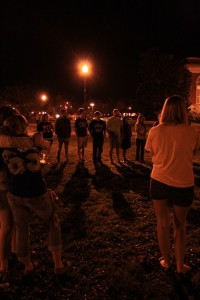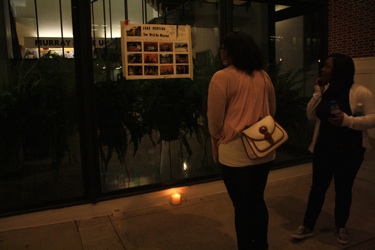
University officials, accompanied by representatives from the Murray State Counseling and Testing Center and the Four Rivers Behavioral Health held a meeting March 15 for faculty, staff and students who were directly impacted by the student death outside the Price Doyle Fine Arts Center that morning.
Nearby in the Quad, a group of nearly 20 students gathered and held hands to remember Jacob Derting, 20, junior from Bardstown, Ky., after he fell to his death from the seventh floor of the Fine Arts Center. Officials have officially determined the incident was a suicide.
Since that Thursday morning, the University community has reacted strongly. Hundreds of students gathered around Old Fine Arts Building and Waterfield Library looking on as emergency management officials used sheets and visibility shields to block the scene of Derting’s body. He was found between the Robert E. Johnson Theater and the elevator base of the Price Doyle Fine Arts Building at the entrance to the Zen Garden.
Some students and faculty stood with hands on heads or phones to ears while others stooped to the ground and wept or prayed.
Reactions to Derting’s death at about 9:25 that Thursday morning swept campus, prompting the University to open the Counseling and Testing Center in the Applied Science Building and the Psychological Center in Wells Hall to students.
After 4:30 p.m., those seeking emotional counsel were urged to contact Public Safety, but officials organized a 7:30 p.m. meeting to plan the University’s faculty response to the tragedy. Students were encouraged to take part as well.
“Our whole community has received a great shock,” Bill Allbritten, director of the Counseling and Testing Center, told the group of students and faculty in attendance.
Many of those who attended had seen Derting’s body fall from the building or seen him on the ground. One girl said the experience scarred her eyes and ruined her perception of the building she’d grown to love.
Allbritten said feelings like that are normal and are often associated with deep anger or sadness. He said it was important, however that those affected by the event not keep emotions like that bottled up.
Don Robertson, vice president of Student Affairs, and Allbritten discussed the different ways students cope with tragic and sudden losses of life in tight-knit community.
He said the student reaction to the event was evident. Members of the Anime Club, of which Derting was a part, taped a sign on the windows of Price Doyle Fine Arts Building near where responders had found Derting’s body.
A single candle flickered through the night as students leaving the Step Show passed by and would stand silently looking at his pictures before walking away.
Robertson told attendees that officials had considered planting a tree in memory of Derting. Some students said they did not think any memorial would be appropriate considering the nature of his death.
The Counseling and Testing Center most recently held a meeting Wednesday night to give everyone affected by the incident an opportunity to further discuss their feelings.
During the meeting Allbritten addressed the group and said Derting made a terrible and horrific choice to end his life.
“No one other than Jacob bears the responsibility for that choice,” Allbritten said.
He said there may be a prayer service held in the near future to honor the life Derting lived, but not the choice he made to end his life.
“None of us should feel guilty for what happened,” Allbritten said.
He said if anyone knows someone who shows signs of depression or seems to be struggling with their daily activities they should try to be a friend to them.
Allbritten also encouraged attendees to speak with counseling and testing employees to help cope with the event.
Alysha Marvin, sophomore from Murray, said she knew Derting from the Anime Club and is struggling to deal with his death.
“At first I didn’t deal with it at all,” Marvin said.
At the meeting, Marvin tearfully discussed the events that happened after the incident.
She said at first she ran away from the building because she didn’t think it was someone she knew. Later she discovered it was Derting, whom she saw walking to class every morning and participated in club activities with.
The effects to campus from the March 15 tragedy reached across the student body and deep into those involved.
One such individual, who spoke to The News on condition of anonymity, said what she encountered changed her life forever.
She said she witnessed Derting’s fall and tried to get help and talk to him when he stood in the window.
Kevin Qualls, assistant professor in journalism and mass communication, heard a scream through an open window and looked out to see the same scene. He said he too tried to talk to Derting.
Police responded quickly, getting statements from both individuals, while University officials offered services at both the Counseling and Testing Center and the Murray State Physiological Center.
While Qualls opted out of that kind of help, he was appreciative of what the University had been able to offer at such quick a time.
“The University couldn’t do anything to help that boy at that time, but I thought they were very responsive to providing care to those who were at this event,” he said.
Robertson said the University’s response was part of an organized plan along with many others that he said is well prepared for and constantly improved.
“Very quickly, the resources came together with the Counseling Center, the Psychological Center, our campus ministers, Four Rivers,” he said. “So, people mobilized very quickly to be available to assist individuals.”
He said the March 15 meeting and the session recently held Wednesday are being used to help and assess the need for more help for affected individuals.
“We will gauge from that meeting whether we need more,” he said. “Certainly the individual counseling will continue.”
Allbritten said he is ready to be able to be a part of the grieving and hurting processes of students and faculty. He said the emotions students address now are normal and expected healthy transitions.
“I think it recognizes and validates the fact that they’re hurting,” he said. “We can provide factual information about how people react to suicides.”
He said some typical responses include grief, shock and anger. Sometimes, however, individuals can look inward and worry about their own feelings and what those feelings mean.
President Randy Dunn said he is proud of the University’s response to the tragedy.
“I think it does bring to mind, particularly at this time of year, there are stressors students can have and if they ever get that feeling we have a lot of resources available,” he said. “One of the things we’ll do through public safety and emergency management is a post review to see if there’s something we could do better in a similar type of crisis.”
Staff writer Olivia Medovich contributed to this story.




























































































